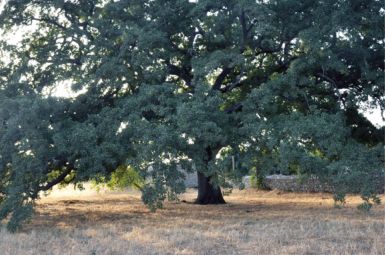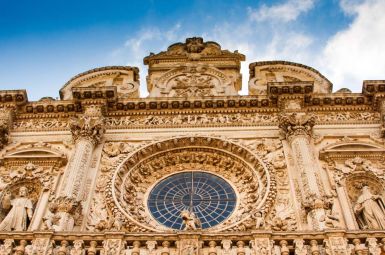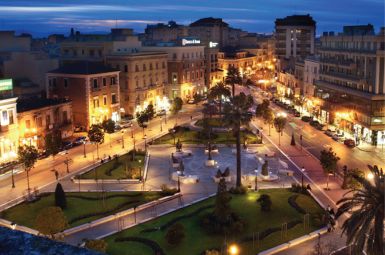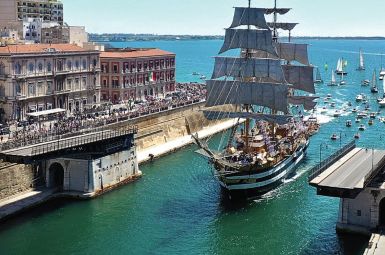
Santo Stefano di Sessanio
Il Borgo di Santo Stefano di Sessanio
Santo Stefano di Sessanio: Il Borgo Rinato, Custode di un Tempo Sospeso
Santo Stefano di Sessanio (AQ) non è una semplice località; è un’esperienza sensoriale e storica. Incastonato a oltre 1250 metri d’altezza nel cuore del Parco Nazionale del Gran Sasso e Monti della Laga, questo borgo medievale è rinato dalle sue ceneri, trasformandosi in un modello internazionale di turismo etico e conservazione filologica. Visitare Santo Stefano significa compiere un salto in un’epoca in cui il tempo era scandito dal ritmo della transumanza e dalla ricchezza del commercio della lana.L’Albergo Diffuso: Un Museo a Cielo Aperto
Il destino di Santo Stefano, come quello di molti borghi montani, sembrava segnato dall’abbandono. La sua rinascita è legata a un progetto visionario che ne ha conservato l’anima intatta.- Il Progetto Sextantio: Un imprenditore italo-svedese si è innamorato del borgo negli anni ’90, decidendo di acquistarlo e restaurarlo per farne un Albergo Diffuso. Questo concetto unico non prevede la costruzione di un hotel, ma trasforma le vecchie case contadine e signorili in stanze e suite, disseminando accoglienza, ristorazione e servizi lungo i vicoli del paese.
- Conservazione Maniacale: La filosofia di restauro è stata rigorosissima, filologica e conservativa. Le pareti mantengono le tracce del vissuto antico, gli arredi sono ricavati da oggetti di recupero e archivi storici, e le stanze spesso non hanno televisione o frigobar. L’unica concessione alla modernità è un riscaldamento efficiente e bagni moderni, sapientemente integrati. Dormire qui significa sperimentare un’autentica vita medievale, seppur con i comfort essenziali.
L’Età dell’Oro: La Lana dei Medici
Il potere e la ricchezza di Santo Stefano erano storicamente legati a un prodotto particolare e molto richiesto.- La Lana Carfagna: Il borgo fu per secoli un fiorente “porto” montano per il commercio della Lana Carfagna, una lana nera e grezza molto resistente, utilizzata per confezionare i sai dei monaci e le divise dei militari.
- L’Influenza Medicea: Tra il XVI e il XVIII secolo, Santo Stefano passò sotto il controllo dei De’ Medici di Firenze. La famiglia, interessata a centralizzare il commercio della lana, rese il borgo un punto nevralgico tra il Regno di Napoli e il Nord. Ancora oggi, sulla Porta Medicea, si può ammirare lo stemma della potente dinastia fiorentina.
I Simboli Architettonici
Nonostante il sisma del 2009 abbia causato gravi danni (in particolare al simbolo del paese), l’integrità architettonica è stata preservata e ripristinata.- La Torre Medicea (o Torre del Borgo): Simbolo inconfondibile di Santo Stefano, la torre cilindrica in pietra era la struttura più alta. Crollata quasi completamente durante il terremoto del 2009, è stata oggetto di una meticolosa e fondamentale opera di ricostruzione che ne ha restituito la maestosità originaria.
- Il Tappeto di Pietra: Passeggiare per i vicoli significa percorrere un’intricata rete di strade lastricate in pietra (spesso a spina di pesce), che creano un’atmosfera ovattata e senza tempo.
Santo Stefano di Sessanio è la dimostrazione che l’identità è la risorsa più preziosa. È un luogo di pace, silenzio e autentica bellezza italiana. Sei pronto a lasciare fuori il rumore del mondo moderno e a immergerti nella storia?
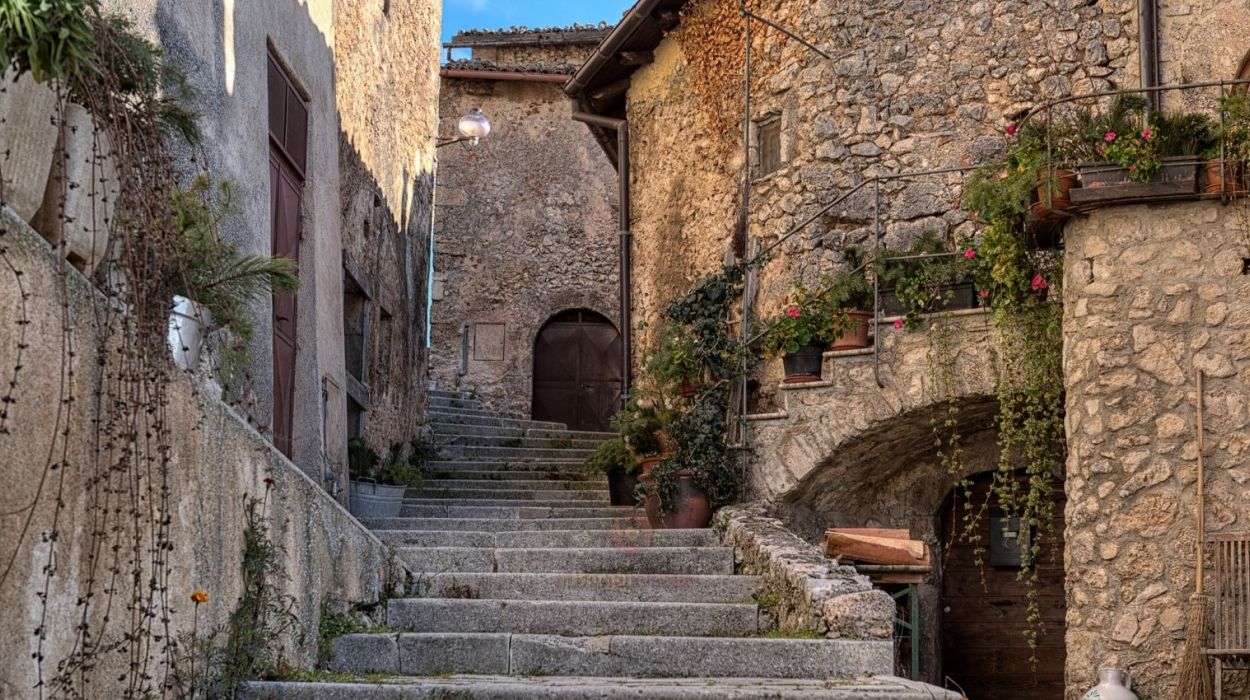
Il Borgo d’Italia
tutto da scoprire ed esplorare
Monumenti
Santo Stefano di Sessanio: Il Patrimonio Architettonico e l’Arte della Conservazione
Santo Stefano di Sessanio (AQ) non è un borgo di grandi piazze monumentali o rovine romane, ma è esso stesso un monumento. La sua architettura è la testimonianza palpabile di un passato fiorente legato alla transumanza e al commercio della lana, preservato grazie a un approccio unico di conservazione filologica. I veri monumenti qui sono le case in pietra, i vicoli e gli elementi che definiscono l’identità del paese.
Ecco gli elementi architettonici e storici che raccontano la storia di Santo Stefano di Sessanio, Bandiera Arancione del Touring Club.
1. La Torre Medicea (o del Borgo): Il Simbolo della Resilienza
La Torre civica è l’elemento più iconico e drammatico di Santo Stefano, un punto focale che domina il panorama.
- Funzione e Struttura: Eretta in epoca medievale e poi rafforzata sotto il dominio dei Medici (da cui prende il nome), la torre aveva una forma cilindrica e serviva sia per la difesa che come punto di avvistamento.
- Il Simbolo Ricostruito: La Torre subì un crollo quasi totale con il terremoto del 2009. La sua successiva, meticolosa ricostruzione filologica, pezzo per pezzo, è diventata un monumento alla tenacia abruzzese e alla volontà di restituire al borgo la sua identità storica. Oggi svetta di nuovo, solida e fiera, come sentinella del Gran Sasso.
2. I Palazzi e i Portali: Le Tracce della Ricchezza Laniera
L’architettura civile riflette l’antica prosperità del borgo, un tempo centro nevralgico del commercio della lana.
- Palazzo del Capitano (o dei Nobili): Le antiche residenze signorili, ora sapientemente restaurate e integrate nel progetto dell’Albergo Diffuso, mostrano l’eleganza discreta della nobiltà locale. I portali in pietra scolpita, gli stemmi e le piccole corti interne raccontano di un’epoca in cui la lana carfagna arricchiva le famiglie del posto.
3. L’Architettura Religiosa: Fede e Tradizione
Le chiese di Santo Stefano custodiscono tesori d’arte e architettura, sebbene in scala ridotta rispetto ai grandi centri urbani.
- Chiesa di Santo Stefano Martire: La chiesa principale, anch’essa restaurata dopo i danni del sisma, è il cuore spirituale del paese. Al suo interno sono conservati opere d’arte sacra, tra cui una pregevole statua in legno di Santo Stefano e una Madonna con Bambino del XVI secolo.
- Chiesa di Santa Maria in Ruvo: Appena fuori dal borgo, questa chiesa rurale è un esempio di architettura medievale, semplice e robusta, che riflette il legame profondo tra la fede e il lavoro della terra e della pastorizia.
4. Il Borgo Stesso: L’Albergo Diffuso come Monumento
La vera unicità monumentale di Santo Stefano di Sessanio è l’integrità del suo tessuto urbano, conservato come una “capsula del tempo”.
- La Porta Medicea: L’antico ingresso al paese, sormontato dallo stemma dei De’ Medici di Firenze, testimonia il periodo in cui la potente famiglia toscana controllava il commercio della lana, rendendo Santo Stefano un avamposto commerciale strategico.
- L’Unicità del Vissuto: Grazie al progetto dell’Albergo Diffuso, l’intero borgo è stato preservato con una filosofia che considera monumentali anche le tracce dell’uso povero: le pietre annerite dal fumo, i pavimenti in cotto e i soffitti in legno grezzo. Il paese è il museo, e ogni stanza è una teca di storia vissuta.
A Santo Stefano di Sessanio, i monumenti non ti sovrastano, ti accolgono. Sei pronto a camminare in un borgo dove ogni pietra è stata lasciata al suo posto per raccontare una storia millenaria?
Curiosità
Santo Stefano di Sessanio: Il Borgo Rinato, Custode di un Tempo Sospeso
Santo Stefano di Sessanio (AQ) non è una semplice località; è un’esperienza sensoriale e storica. Incastonato a oltre 1250 metri d’altezza nel cuore del Parco Nazionale del Gran Sasso e Monti della Laga, questo borgo medievale è rinato dalle sue ceneri, trasformandosi in un modello internazionale di turismo etico e conservazione filologica.
Visitare Santo Stefano significa compiere un salto in un’epoca in cui il tempo era scandito dal ritmo della transumanza e dalla ricchezza del commercio della lana.
1. L’Albergo Diffuso: Un Hotel che è un Paese
La curiosità che ha reso Santo Stefano celebre in tutto il mondo è il suo modello di ospitalità.
- Il Progetto Sextantio: Dopo essere stato quasi abbandonato, il borgo è stato salvato da un imprenditore visionario, Daniele Kihlgren, che ha creato l’Albergo Diffuso Sextantio. Le stanze, le suite, la reception e i servizi non sono raggruppati in un unico edificio, ma sono sparsi e integrati nelle antiche case contadine e signorili del paese.
- Conservazione Estrema: Il restauro è stato ossessivamente filologico. Nelle stanze, troverete materassi di lana artigianali su assi di legno, lenzuola tessute a mano, camino al posto della TV, e niente plastica. L’unico lusso moderno, sapientemente nascosto, è il riscaldamento a pavimento e bagni di design. Non è solo un soggiorno, è un’immersione totale nell’identità storica.
2. La Lana Carfagna e i Signori di Firenze
La ricchezza e l’importanza strategica di Santo Stefano nel Rinascimento derivano da un prodotto molto specifico.
- Il Commercio Nero: Il borgo divenne un centro cruciale per il commercio della Lana Carfagna, una lana nera e grezza, ma estremamente resistente e isolante. Questa lana era molto richiesta per confezionare i sai dei monaci e le divise militari in tutto il Regno di Napoli.
- Lo Stemma Mediceo: A testimonianza del suo potere economico, il paese fu amministrato per circa due secoli dai potenti De’ Medici di Firenze. Ancora oggi, sulla Porta Medicea, è visibile lo stemma della celebre dinastia fiorentina, a simboleggiare l’antico legame commerciale che univa questo piccolo borgo montano alla Firenze rinascimentale.
3. Il Simbolo Caduto e Risorto
Il borgo ha pagato un prezzo altissimo nel recente passato, ma ha dimostrato una forza incredibile nel ricostruire la propria icona.
- Il Crollo del 2009: La Torre Medicea (o Torre del Borgo), il simbolo cilindrico che svettava sulla sommità del paese, è crollata quasi completamente durante il devastante terremoto dell’Aquila del 2009.
- La Ricostruzione Fedele: Dopo anni di impegno, la Torre è stata ricostruita con meticolosa attenzione filologica, pezzo per pezzo, riportando il skyline di Santo Stefano alla sua fisionomia storica. La sua ricostruzione è diventata il simbolo della resilienza abruzzese.
4. Il Tesoro Gastronomico: La Lenticchia DOC
La purezza dell’ambiente montano ha garantito la conservazione di un prodotto agricolo d’eccellenza.
- La Lenticchia di Santo Stefano: Il prodotto tipico più famoso è la Lenticchia di Santo Stefano di Sessanio, una lenticchia piccola, dal sapore delicato e dalla buccia molto sottile. Viene coltivata sull’altopiano di Campo Imperatore e non necessita di ammollo prima della cottura, rendendola una prelibatezza apprezzata dagli chef e tutelata come Presidio Slow Food.
Santo Stefano di Sessanio è un invito alla lentezza, un luogo dove ogni pietra, ogni uscio e ogni sapore ha una storia millenaria da raccontare. Sei pronto a vivere un’esperienza che va oltre il semplice turismo?
Personaggi
Santo Stefano di Sessanio: Le Figure Storiche Nemiche della Dimenticanza
Santo Stefano di Sessanio (AQ), sebbene oggi celebre per la sua architettura restaurata e l’atmosfera da “borgo-albergo”, non ha dato i natali a generali o artisti di fama mondiale come le grandi capitali. La sua importanza storica e i suoi “personaggi” sono radicati nell’economia, nell’erudizione locale e nelle figure che, nel tempo, hanno lottato contro l’oblio.
In un borgo montano, i personaggi più influenti sono stati i custodi della memoria e coloro che hanno lasciato un segno nel tessuto economico e istituzionale, spesso legati alla ricchezza derivante dal commercio della lana.
1. I Signori Feudali: I Medici e il Potere Commerciale
Pur non essendo nativi del luogo, la famiglia che più ha influenzato e “reso famosa” Santo Stefano fu quella che ne detenne il feudo.
- La Dinastia Medicea: Il periodo di massimo splendore economico del borgo è direttamente legato alla potente famiglia fiorentina dei De’ Medici. Sebbene i Medici fossero fiorentini, il loro acquisto della baronia di Carapelle (di cui Santo Stefano faceva parte) nel XVI secolo trasformò il paese in un cruciale centro di raccolta e lavorazione della lana carfagna. Lo stemma dei Medici, ancora visibile sulla Porta Medicea, è un monumeno alla loro influenza e alla prosperità che portarono.
2. Gli Eruditi e i Custodi della Memoria
Nel panorama dei nativi, l’importanza storica si misura nell’erudizione, essenziale per preservare la cultura di un luogo isolato.
- Alfonso Colarossi-Mancini: Storico e studioso, sebbene la sua attività fosse più legata ai borghi vicini della Valle del Sagittario, rappresenta la tipica figura dell’erudito abruzzese che ha lavorato instancabilmente per documentare la storia, gli usi e i costumi di queste terre montane. Uomini come lui, provenienti da questo contesto, furono i veri custodi dell’identità.
- I Notai e gli Amministratori: Come in ogni borgo cruciale per il commercio e l’amministrazione feudale, Santo Stefano ha generato nel tempo una classe di notai, mercanti e amministratori locali che, pur non essendo noti al grande pubblico, gestivano la complessa rete economica legata alla transumanza e al commercio della lana, mantenendo viva l’importanza politica del paese.
3. Il Personaggio Contemporaneo: Il Salvatore
Nella storia recente, il personaggio più celebre legato a Santo Stefano non è un nativo, ma l’uomo che ne ha riscritto il destino.
- Daniele Kihlgren: L’imprenditore italo-svedese che, innamoratosi del borgo, ha dato vita al progetto dell’Albergo Diffuso Sextantio. Il suo approccio di restauro filologico e la sua visione di turismo etico hanno non solo salvato Santo Stefano dall’abbandono, ma lo hanno reso famoso nel mondo come modello di conservazione architettonica e culturale. La sua figura è indissolubilmente legata alla rinascita moderna del paese.
A Santo Stefano di Sessanio, l’importanza non è un fatto di celebrità, ma di resistenza. Il borgo è un monumento vivente alle figure che, nel silenzio della montagna, hanno saputo costruire e preservare la sua ricchezza. Sei pronto a scoprirne le tracce silenziose?
Ricette Tipiche
Santo Stefano di Sessanio: La Cucina Essenziale Tra Pastori e Spezie Medicee 🌿
La gastronomia di Santo Stefano di Sessanio (AQ) è il riflesso della sua storia unica: una fusione tra l’austerità della montagna appenninica e l’antica ricchezza commerciale legata al dominio dei De’ Medici. La cucina qui è sincera, robusta, e celebra i pochi, eccellenti prodotti dell’altopiano, con un’attenzione particolare ai legumi e alle carni ovine.
Queste ricette sono il sapore autentico di un borgo che ha resistito al tempo, nutrendosi della semplicità e della qualità del suo territorio.
1. Il Piatto Icona: La Lenticchia Regina dell’Altipiano
Se c’è un prodotto che definisce Santo Stefano, è il suo legume, Presidio Slow Food.
Zuppa di Lenticchie di Santo Stefano di Sessanio
Un piatto che è l’emblema della purezza e della resilienza contadina.
- La Materia Prima: La celebre Lenticchia di Santo Stefano è piccola, di colore marrone chiaro, dalla buccia sottilissima che la rende tenera e non necessita di ammollo.
- La Preparazione: La zuppa viene preparata in modo essenziale: lenticchie cotte lentamente con l’acqua, un soffritto leggero di aglio e prezzemolo, e l’immancabile filo d’olio extra vergine d’oliva abruzzese a crudo. A volte viene arricchita con crostini di pane casereccio abbrustolito, permettendo al sapore nobile del legume di emergere in tutta la sua delicatezza.
2. I Primi Robusti: Pasta Fatta a Mano e Sapori Intensi
La tradizione vuole piatti di pasta che “sostengano” i corpi abituati al lavoro in alta quota.
Maccheroni alla Chitarra con Ragù di Mutton
La pasta tipica abruzzese incontra la carne più selvatica e saporita del pascolo.
- Il Ragù di Castrato: In questa zona, il ragù è spesso preparato con carne di castrato (mutton), il montone adulto, dal sapore molto più intenso e aromatico dell’agnello. La cottura è lenta, con pomodoro e abbondanti aromi selvatici raccolti sui monti.
- La Spinta Aromatica: Data la vicinanza a Navelli, talvolta il ragù viene impreziosito con stimmi di Zafferano, un lusso storico che testimonia il ruolo di Santo Stefano come snodo commerciale.
Gnocchetti di Patate con Sugo di Salsiccia e Funghi
Un piatto che unisce i prodotti dell’orto (patate) a quelli del bosco e del pascolo.
- Gnocchetti Caserecci: Le patate di montagna, farinose e saporite, sono perfette per creare gnocchetti morbidi.
- Condimento del Bosco: Il sugo è spesso una combinazione ricca di salsiccia fresca macinata e funghi porcini (o altre varietà locali) raccolti nei boschi del Gran Sasso, offrendo un gusto terroso e avvolgente.
3. I Secondi: Il Cuore della Transumanza
La carne ovina è il pilastro della dieta, consumata in modi che ne esaltano la fibra e il sapore.
Pecora al Cotturo (o in Pignata)
Il piatto più antico e rappresentativo della tradizione pastorale della Baronia di Carapelle.
- La Cottura Rituale: La carne di pecora viene cotta per un tempo lunghissimo (anche 5-6 ore) in un paiolo di rame (cutturo o pignata), con pochissima acqua, patate, cipolle e odori. La carne si ammorbidisce fino a staccarsi dall’osso, rilasciando un brodo denso e saporitissimo. È un piatto di grande convivialità, perfetto per le fredde serate invernali.
La cucina di Santo Stefano di Sessanio è un racconto di fatica e celebrazione. Un pasto qui non è solo cibo, ma un tuffo in una storia millenaria. Sei pronto ad assaggiare la vera essenza del Gran Sasso?
